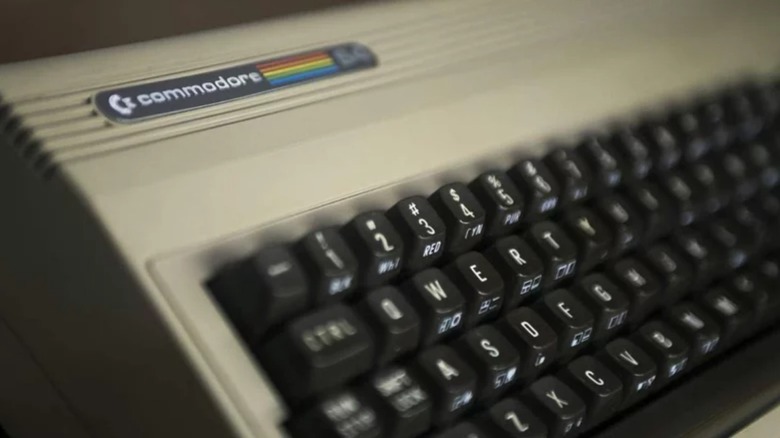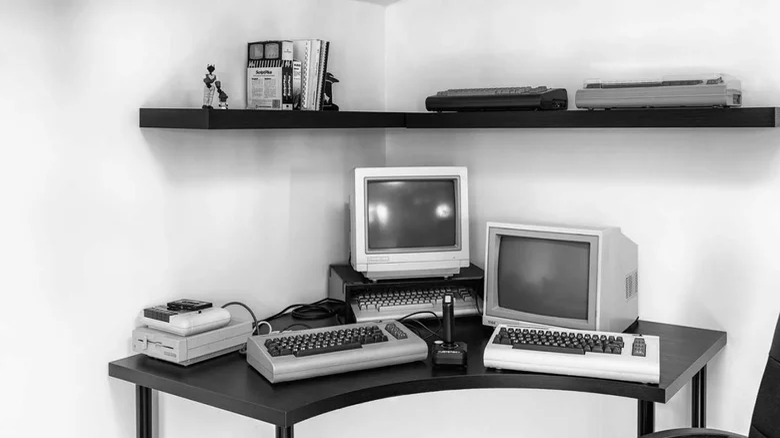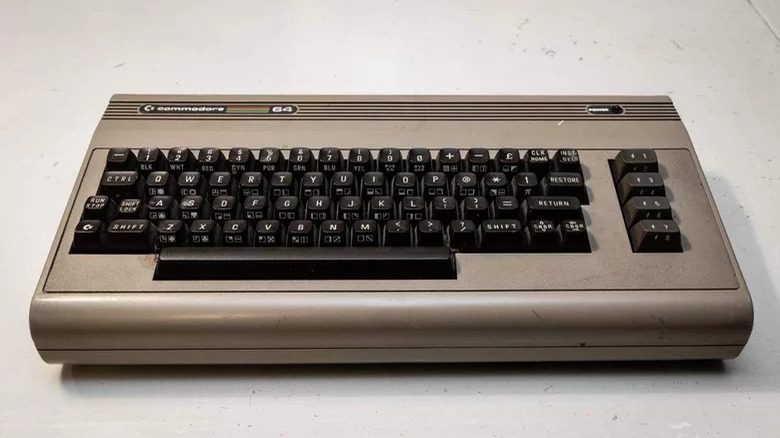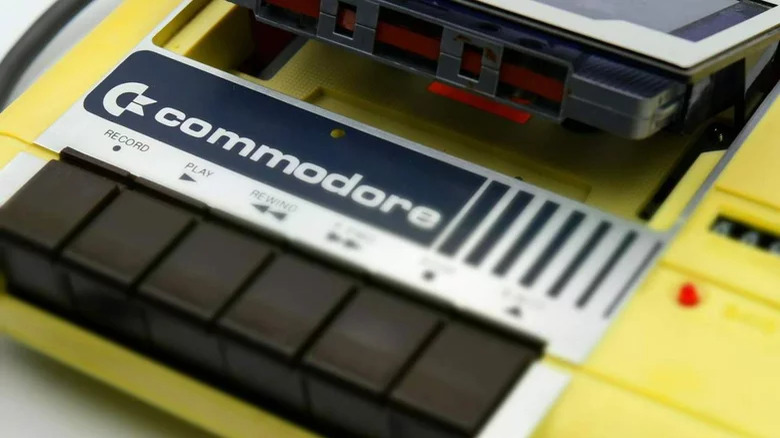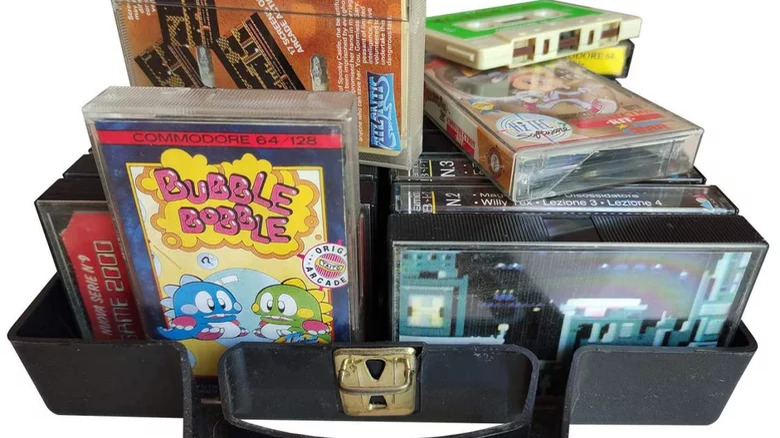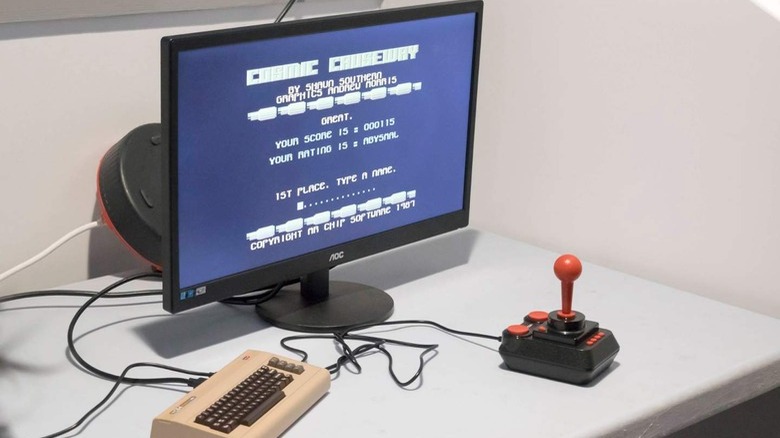10 Reasons The Commodore 64 Was Such A Special Computer
The Commodore 64, or C64, showed up on the market in 1982, at a time when personal computers were in their infancy but also growing exponentially. Previously, computer technology was the stuff of massive mainframes in research departments or government organizations. While these companies produced computers suitable for use in the home, it did not mean everyone could afford one.
In fact, having a computer in the home was quite a privilege back then — and making computers more accessible stands as the greatest legacy of the C64. Computer technology in the 1970s went through tumultuous changes in adapting from serving primarily institutional customers and on to creating products for consumers at home. Video games and personal computers burst onto the scene at about the same time and offered consumers new ways to interact with technology. But Commodore changed everything, and its iconic product, the Commodore 64, was special for myriad reasons. Here are 10 of them.
The time was right for a Commodore 64 to appear
This stage was set for a company to come along and take the market by storm with an innovative product for the masses, and that is exactly what Commodore did. Apple, Radio Shack, and IBM introduced personal computers in the late '70s and early '80s that, for the first time, enabled some families to own a computer and use it at home for a variety of purposes, according to Brittanica.
People found multiple uses for personal computers such as accounting, word processing, and video games. At the same time these machines entered the market, Brittanica noted, technology rapidly developed, causing computers to become ever more powerful and less expensive simultaneously. Once people got a taste for new technology, the desire to own it increased exponentially. But with the high cost of existing hardware, room existed in the market for a low-cost player to fulfill demand.
The Commodore 64 made home PCs affordable
While Commodore had been an established technology company already for a couple of decades, CEO Jack Tramiel made many decisions that resulted in lowering manufacturing costs, including purchasing 100% of chip maker MOS Technology, Inc. This brought production costs down significantly and allowed the brand to undercut its rivals by hundreds of dollars. At the time of introduction, the retail price of the C64 was $595, according to Smithsonian.
In 1984, the cost of an Apple IIe 64k MSRP was $1395, the cost of a Radio Shack TRS-80 III 16k was $999, and the IBM PC 64k was $1,355, as stated in Commodore advertising of the day. While the C64 may not have come with the same equipment, the low initial cost of ownership made it appealing to average working-class families.
Furthermore, because of the falling cost of componentry at the time, the MSRP of the C64 fell to as low as $230 by the mid-80s, records at the company's website how. This meant that anyone who purchased one should have had the ability to budget for extra drives or other peripherals to suit their needs. The vertical integration of Commodore Business Machines, including ownership of their own chip maker, allowed them to sell this low-cost leader to become the best-selling single computer model of all time.
Personal computers became a home staple
Having access to a computer within reach of regular working people was revolutionary in itself. Not long before the introduction of the C64, computers were behemoths toiling away in universities or the Department of Defense, managing complex calculations of significant science projects or managing human resources and budgets for these giant organizations.
The machines took up the space of small warehouses or entire floors in office buildings, and easily cost the equivalent of an entire year salary of a middle manager in a dull advertising firm. Computers had been those things that sent astronauts to space or helped to cure disease, and now they could help kids with math homework and book reports. At first, only the privileged could afford to have a computer in the home as they first became staples of wealthy suburbs or high-rise city apartments.
Now, not only could the middle class afford one, but Commodore made the cunning decision to retail them in department stores instead of specialty electronics outfits or office supply stores. The C64 was the personal computer for the masses.
It brought families together
Another monumental decision made by Commodore was to enable the C64 to be hooked up to a standard color television. Smithsonian noted that by 1980, most homes had a color television, which eliminated another major expense involved in buying a new computer. Another likely unintended consequence of this is that it brought the family together into the computer age. Having a television in every room was not nearly as common in the early '80s as it is today, so often the TV available to hook your new C64 to was the only TV in the house.
This forced many families to share one computer and learn together how to use it. With the inclusion of a game slot on the machine itself, adding a joystick meant hours of video gameplay in front of the family TV. While it surely caused countless fights and fueled ever-present sibling rivalry, it also provided bonding opportunities the whole family could enjoy.
Families gained access to home video games
The aforementioned cartridge shot was also a clever decision in the development of the C64. With the introduction of the Atari 2600, home video game consoles exploded onto the consumer electronics scene and became the must-have gifts for millions of children at Christmas for several seasons. Competitors such as the Magnavox Odyssey 2 and Intellivision created a booming video game market that brought many companies with even more ideas to meet demand.
The inclusion of the cartridge slot meant that while the C64 was a competent personal computer capable of word processing and accounting, it could also play video games. It eliminated the need for parents to spend the money to get a computer they wanted as well as a video game console for the kids. They need only buy a joystick or two and it was ready to go. Game cartridges for C64 were sold alongside those for Atari or Coleco, and dozens of publishers created games for the C64 as well as porting games from other systems to the Commodore. It proved to be the perfect companion to any Gen X latchkey kid winding down after school.
It offered many upgrades
While the C64 did not arrive in the box with much more than a power cord, many peripherals and expansions existed. Some of the basic accessories were a cassette tape drive, a 5.25-inch floppy drive, and joysticks. In addition to this, many chose to add a printer, which could come in dot-matrix, daisy wheel, and plotter format. C64 ports included joystick, ROM cartridge, RF video out, A/V composite video, serial bus, data cassette port, and a user port for connecting Commodore brand printers and other peripherals. Printers from other manufacturers required an adapter to utilize the user port. While Commodore produced all of these typical accessories, they also produced many unique and novel devices to expand the capabilities of the C64.
One such interesting add-on is the Commodore Music Maker, a plastic shell that sits atop the device with piano keys that depress specified alpha keys below to produce music. It accompanied music-making software on a ROM cartridge that allowed the playing of music with a three-voice, four-octave synthesizer. Commodore offered a mouse, modem, monitor, hard drive, and more while third-party vendors optimized the C64 for dozens of other uses, including a very early automotive navigation system. For its time, the ends of the imagination seemed only hampered by the limits of the processor and RAM, yet the C64 proved to be a versatile and capable machine with endless opportunities for upgrades.
It introduced gaming to many kids for the first time
As noted above, the C64 was indispensable to latchkey kids for passing time waiting for parents to get home from work. Yet many of these kids had little exposure to video games outside the coin-operated games ubiquitous in their local pizza parlor. This meant that kids only played the games with the biggest names published by big companies that could finance large-scale manufacturing of expensive electronics for commercial sale.
The BBC notes that the C64 meant kids could discover titles from independent publishers and even swap cartridges and floppy disks with friends to play and explore unfamiliar titles — without shoveling a pocketful of change into a machine in a smoke-filled family restaurant. In the peacefulness of their own homes, they could play action and arcade games along with strategy and even role-playing games over and over until they grew tired and fell asleep, or the nightly news began and the parents kicked the children out of the living room for the evening.
The C64 introduced a digital world to a generation that grew up to be the creators and innovators of much of the technology we use every day, and it holds a special place for having done that.
BASIC programming is easy to learn
Today, coding is a hot topic and a potentially lucrative career path. Nearly everything in the modern age utilizes code embedded into chips and memory across devices complex, simple, and mundane. But in the late '70s and early '80s, computer code was the domain of the nerds and brainiacs among us. It was literally a foreign language and difficult to understand and fairly obscure in popular culture. However, as personal computers gained traction and more and more kids and adults alike found exposure to computers at home, work, or school, the need and desire to learn about code blossomed.
The C64, like many other contemporary machines, ran on a code known as Beginners' All-Purpose Symbolic Instruction Code, or BASIC. People all across the world immersed themselves in a world of ones and zeros with bits and bytes becoming familiar to the lexicon of everyday conversation. Although BASIC is a computer programming language and is capable of creating complex programs with a high level of expertise, users can learn basic commands and how to input lines of code to create simplistic programs with relative ease.
Programs were often printed in computer magazines of the time and users could input the code into their C64 to execute a program, a novel exercise with the introduction of the home computer. BASIC remained the foundation of the C64 through its entire run from 1982 to 1994.
Lots of software was available
Coming into the market at such a low price meant there existed a great demand for software. After all, what good is a computer with no software to run on it? Commodore published a plethora of titles, targeting a diverse set of age groups and demographics. But with BASIC programming already widespread in the market, scores of developers rushed to fulfill demand.
During the 12 years of production, an estimated 10,000 software titles were written for the C64. Much like a modern app store, there was no limit to what could be found to run on the C64, although these titles mostly required a physical disc or tape to load into memory. Commodore games were sold in retail stores and specialty shops along with the hardware. Mail-order catalogs and flyers, such as Protecto Enterprizes, also enticed users into sending checks in to receive disks by mail.
C64 is still supported by loyal fans
When the C64 ended production in 1994, there were millions of units in homes across the continents. They had been loyal workhorses performing computations and calculations, rendering sights and sounds for video games, spreadsheets, digital music, animations, and more. When something is produced for over a decade in mass quantity for the consumer market, it goes beyond being a useful machine. At that point, it enters into the popular culture and becomes more than the sum of its parts.
Fans of the C64 grew up and moved on to more modern and capable equipment but did not forget their trusty 64K companion. As such, some people never stopped using them, while others set them in the back of a closet to lie dormant for another decade or so. But after the start of the new millennium, yearning for nostalgia set in, and a resurgence of interest in the older hardware from the early computer age happened.
Currently, archives of C64 software live on the web with countless users adding to the repositories every day. In addition to the maintenance of these web archives, other companies have reissued the C64 in various formats, from a mini version geared toward games, and a full-fledged reproduction with modern USB ports that runs nearly identically to the original. The C64 left a deep enough impression in the public psyche that it shall avoid falling into obscurity for years to come.
